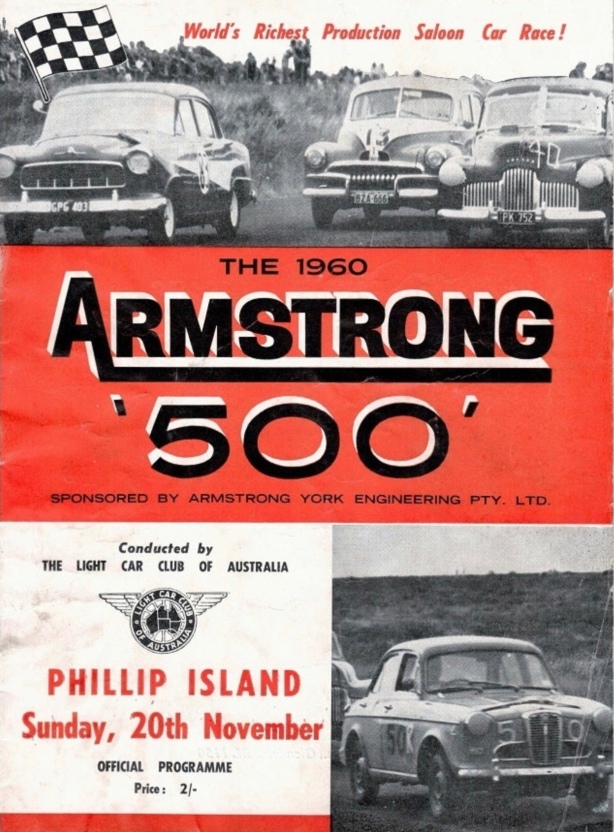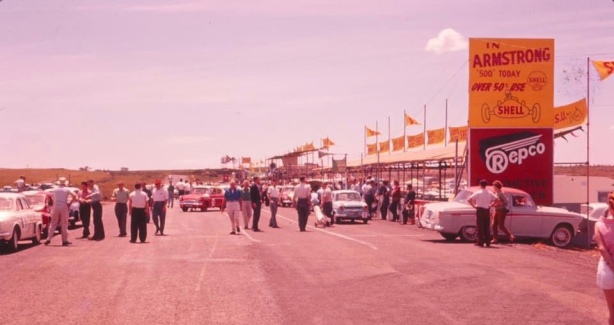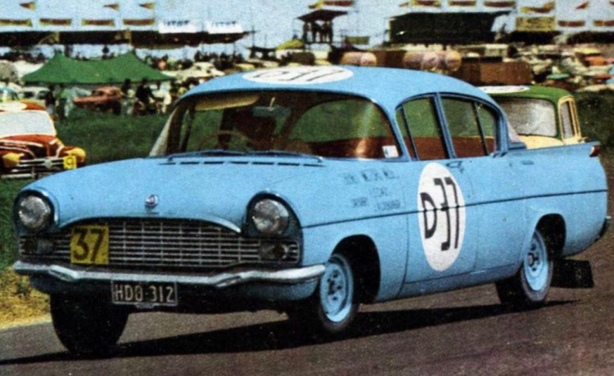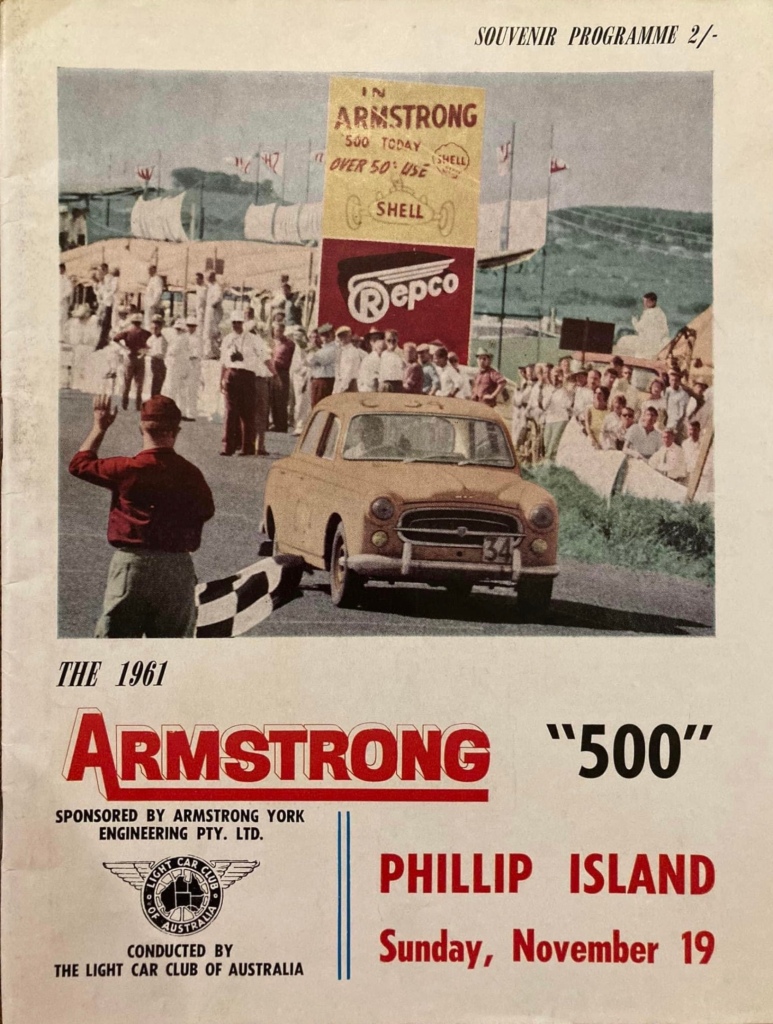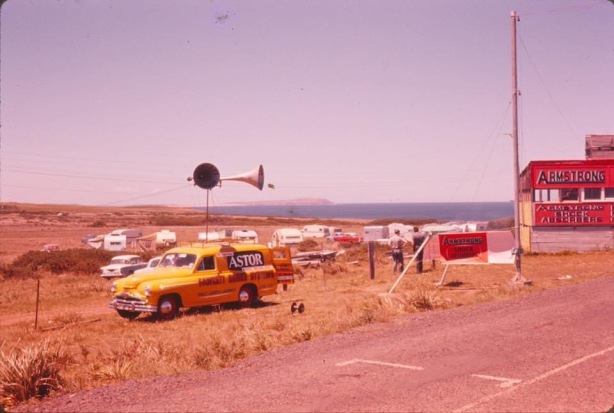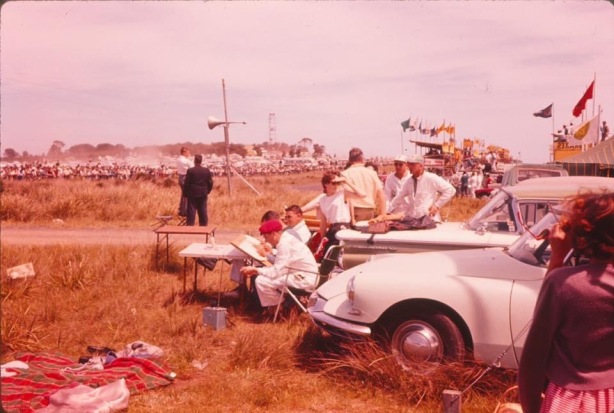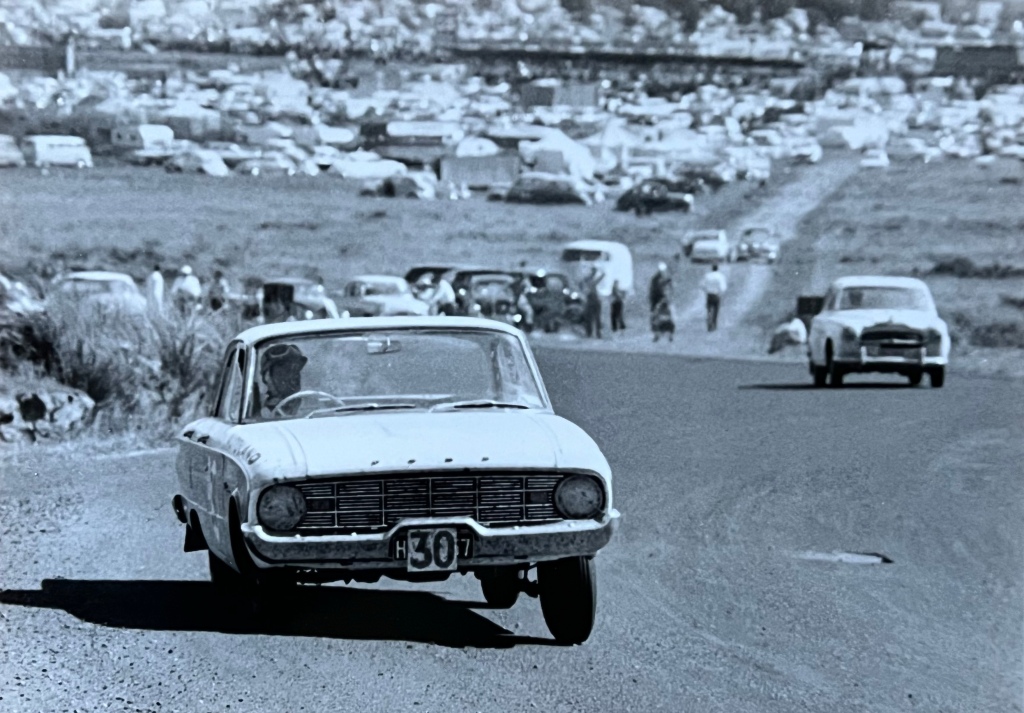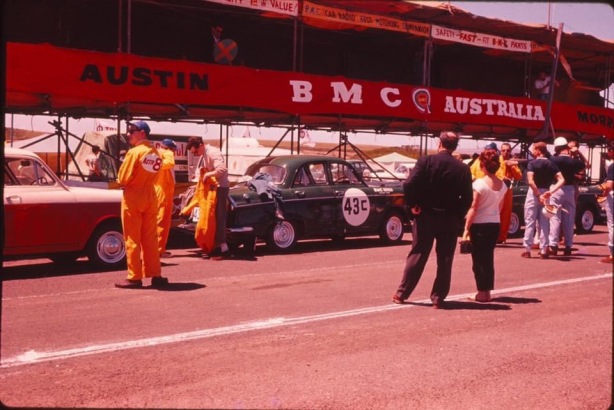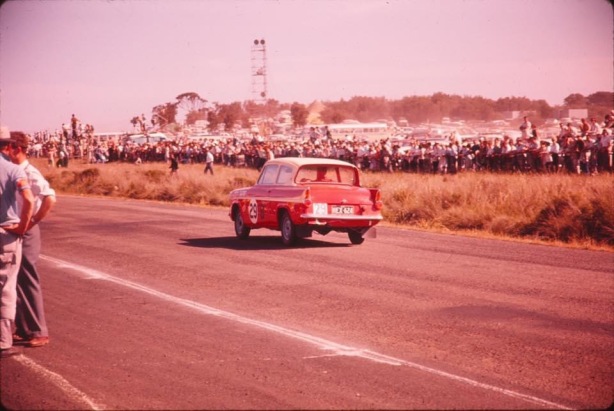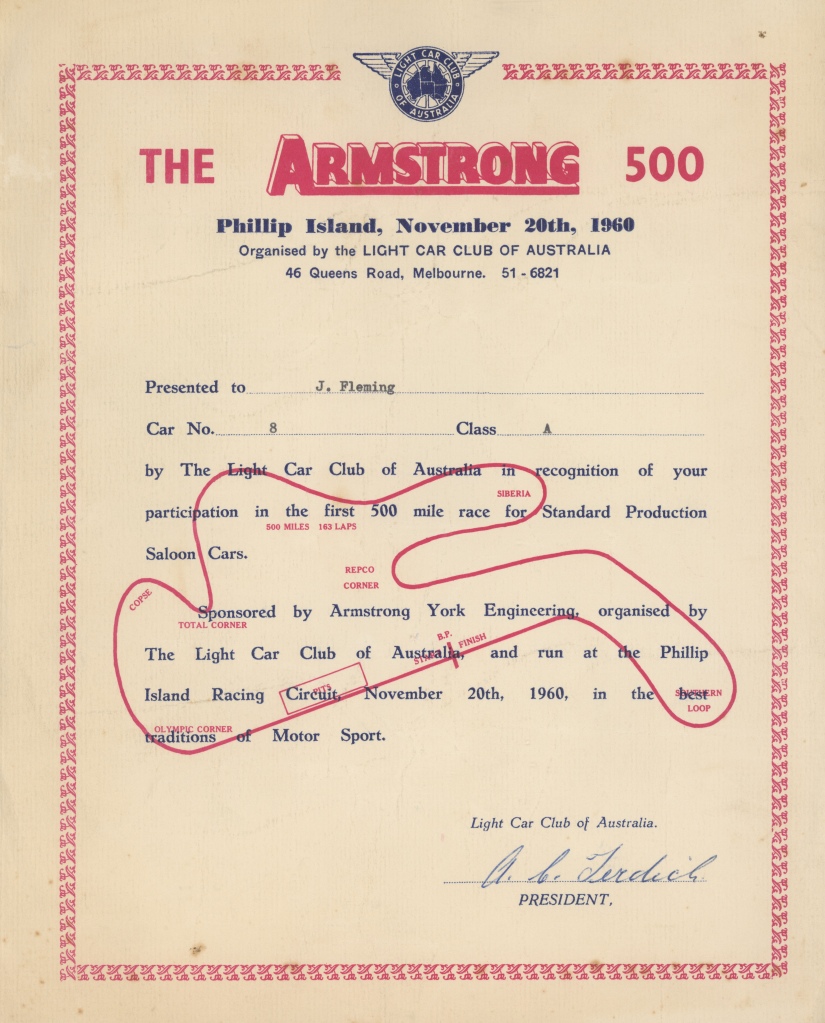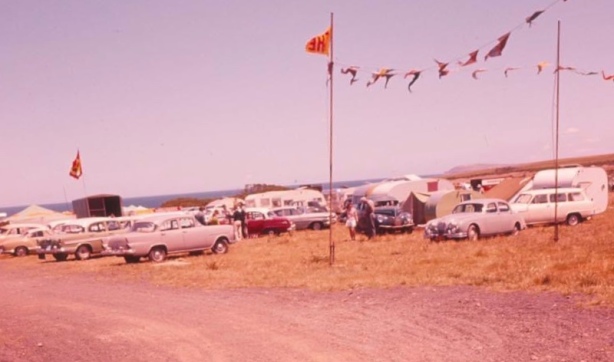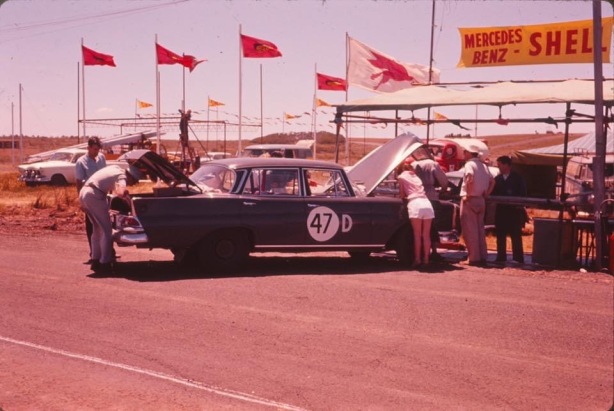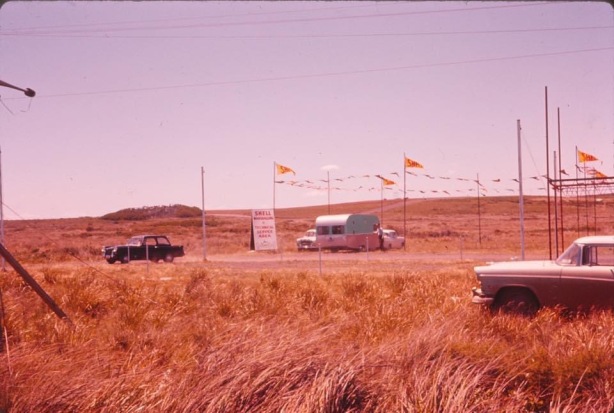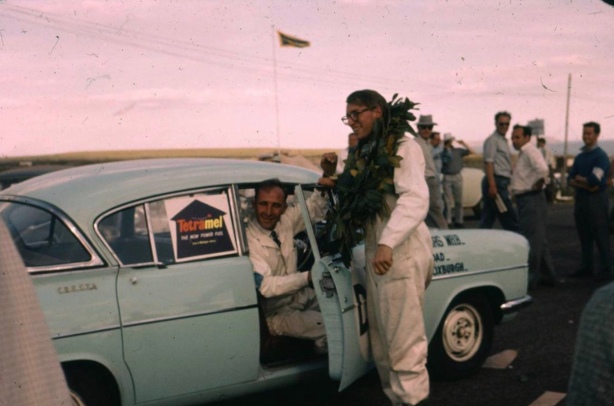
(K Harris)
The Northern Territory entered Jaguar Mk7 of B Kingston and a Holden 48-215 line up for fuel at Bonds Chalet, Alice Springs during the 1953 Redex Round Australia Trial on 9/10 September…
It’s a quintessential Alice Springs scene, the red-brown parched soil and mid-green eucalypts framed in the distance by the MacDonell Ranges. Most of us of a certain age attended Primary Schools with artwork by Albert Namatjira, in these hues, hanging on the classroom walls.
Adelaide based Bonds Bus Tours provided ‘Parc Ferme’ and refuelling facilities for the rally in Alice Springs. These amazing photos were taken by a longtime employee, Kevin Harris. Rolled gold they are too, even though they are of the cars at rest, with one exception.

The post-war pent-up demand for entertainment, in those much simpler times was massive. Bouyed by an economy which was starting to boom, Australians turned out in their thousands to watch the progress of the 187 participants in the 1953 Redex Round Australia Trial.
In part it was because most roads west of Adelaide were challenging to say the least. The fact that the rules provided that cars were largely unmodified meant that the average man in the street could see how his car, or the one he aspired to own went created some interest. Cars were stock other than for underbody protection, carburettor, exhaust, lighting and instrument modifications.
Many of Australia’s better racing drivers competed, not that they were all household names by any stretch, but many were by the end of the decade in part due to their trial exploits in the years to come. The media, by the standards of the day provided massive coverage also fuelling the fire of public interest.

Stan Jones Holden 48-215 and O Yates Austin A40 Atlantic, Stan a tough nut purpose built for an endurance event like this, even if his press-on style was not (K Harris)
Fifty thousand people lined the streets of Sydney from the start at the Sydney Showgrounds at Centennial Park on 30 August and lined the route through the major cities the circus traversed. Whilst the event was styled as a reliability trial it was effectively a race as we shall see. So there were plenty of acts of derring do and accidents aplenty.
Name drivers included ‘Gelignite Jack ‘Murray, the ‘Preston Holden Team’ of Holden 48-215’s driven by Lex Davison, Stan Jones and Charlie Dean. David McKay and ‘Curley’ Brydon ran Austin A40’s and Jack Brabham a Holden 48-215. Norman (father of Alan) Hamilton, the Porsche importer entered a 356, Frank Kleinig a Morris Minor. Jack Davey ran a Ford Customline- the popular radio show host broadcast on local radio stations along the route and had a can of hairspray in the glovebox to look his best at all times. Bill McLachlan ran a Customline, Don Gorringe a Jowett Javelin, Peter Antill, a trials ace raced a Plymouth with Eddie Perkins in a Rover 75, Laurie Whitehead ran a Citroen and John Crouch a Peugeot 203, Ken Tubman another.

Norman Hamilton, Porsche 356, I wonder if this car still exists? (unattributed)
The entry included all of the above as well as an Allard, Vauxhall Velox, Mercedes 200D diesels, MG TD’s, De Soto, Humber Super Snipes and a swag of big, strong 1948 Ford V8’s. In addition were Peugeot 203, Jaguar Mk7, Chrysler Airflow, Hudson Terraplane, Ford Anglia, Zephyr and Consul, Singer 9, Simca, Vanguard, Hillman, Riley and so on!
It isn’t my plan to cover the trial in detail but rather to showcase the Kevin Harris photographs taken during the Alice Springs stopover on September 9 and 19 1953. A summary of the trial, a heavily truncated version of a couple of other articles follows.

B Gurdon Austin A40 and Lex Davison Holden 48-215- the ever versatile Victorian racer/businessman was quick in anything or any sort of event from Trials to GP cars (K Harris)
Ted Hoy’s Chrysler Airflow, car #1 later to play a critical part in the result of the event, was the first to leave the showgrounds at 2pm, the last to travel along Driver Avenue was a Queenslander, Miss J. Hill aboard a Renault 750 at 11.33pm.
150,000 people lined the streets through Sydney’s northern suburbs to Hornsby to watch the start of this amazing 6500 mile adventure, the second longest event of this type in the world at the time. The first breakdown was a Jaguar Mk7 which died near the Hawkesbury River only 52 Km from the start!
The leaders averaged about 50 mph (80 km/h) up the Pacific Highway to Brisbane, with mechanical failure taking points from some of the novices. The first bad accident happened near Gin Gin, when Patience/Binks hospitalised themselves after rolling their Ford V8 down an embankment.
The field didn’t strike unsealed roads until after clearing Rockhampton. The challenges began with corrugations, culverts, cattlegrids, washaways, dry creek beds and everything else the vast brown land could throw at them. McLachlan, one of the favourites, lost two hours 15 minutes with water pump failure on his Customline, but still made the Mackay control on time.
In 24 hours’ rest at Townsville, the organisers counted 177 cars in control with 128 clean-sheeters.

The Antill Chrysler Plymouth, no idea where (unattributed)
At this point the trial stopped being a rally and became a road race.
Word went thru the field that the organisers had decided that if several crews reached Sydney without loss of points, their times on the Townsville – Mt. lsa and Alice Springs – Adelaide sections would decide the winner. They were given 16 hours to cover the 609 miles (980 km) from Townsville to lsa. It was ‘game on’ amongst the racers.
Peter Antill’s Plymouth was fastest with an incredible 13:22. The first car to reach Mt. Isa was Possum Kipling’s, 14 hours 12 minutes after leaving Townsville. He had to get the control officials out of bed, he was so early!
Behind him was a nightmare of crashed cars, irate police and horror stories. Half the field was spread across most of Queensland. Bill McLachlan was directed wrongly in the middle of the night and drove 136 miles (219 km) off course before getting back on the right road, only to hit a cattle grid that had been de-guttered by the field. Stan Jones hit the same grid.

Bonds Alice Springs vista ( K Harris)
Bill Murray rolled his Plymouth, Hamilton’s Porsche hit a kangaroo and deranged its front suspension, driving the rest of the way into the Isa on the undertray. The last car, Anderson in a Skoda, staggered into town after a 24 hour 44 minute trip following a trail of wreckage
The next stage over bitumen to Darwin, was 1098 miles (1760 km) the average set at 44 mph (71 km/h). Antill hit a galah (indigenous bird) which took out his windscreen, his car already had a cracked chassis.
McLachlan had broken his Customline’s diff housing, but the medium-sized cars, like the Holden of Kipling, who was second into Darwin, and the Rover of Perkins, 3rd into control, were in good shape.
‘Wheels’ magazine in its report of the trial wrote: ‘The myth that the only car suited for Australian conditions was the large American vehicle had been exploded’.

‘Parc ferme’ #114 Charlie Deans Holden 48-215, the master engineer taking time away from his Repco Research/Maybach race preparation duties but no doubt keeping some kind of eye on his driver S Jones Esq in one of the other ‘works’ Holdens. Stan very much one of the quickest guys in Australia at the time and stiff not to win the Australian Grand Prix in Maybach 1 that November with mechanical problems ( K Harris)
From Darwin 132 cars set out for an easy drive down the bitumen to Alice Springs for servicing and repairs at Tennant Creek, then on to the Alice.
At Alice Springs the field stopped at Bonds facilities as shown in the photographs. The cars were scheduled in from 8.51am on Saturday the 9th, and out, commencing 12.01am on the 10th.
Of the 41 clean-sheeters who departed Darwin, 38 were there when the field lined up for 368 miles (592 km) of desert to Kingoonya.
This stretch was considered impossible to cover in less than 48 hours- the organisers had set a time of 15 hours 10 minutes. In addition the field were given only one hour’s rest at Kingoonya before despatch for the 424 mile (682 km) run to Adelaide, an an average of 42 mph (68 km/h).
Lex Davison arrived in Kingoonya in an unbelievable 13 hours 39 minutes. Second was Possum Kipling in another Holden in 14:10. Tom Sulman, prominent racer, was fastest in his Humber Super Snipe when he emerged from the desert and drove south to Adelaide.

Magic scene, the Cusso framed between the truck wotizzit? and old Shell bowsers. Driver is S Levy, NSW (K Harris)
By Adelaide there were 11 clean-sheeters. Crews had to be lifted from their cars after up to 60 hours at the wheel without a break!
The road had decimated the field, who limped in with hair-raising tales of tying up rear suspensions with tyre chains, living underground at the opal mining settlement of Coober Pedy, jamming coir matting into a broken front end to keep going and crew members going crazy from the dust and heat.
The field of 11 clean-sheeters who left Adelaide faced only bitumen roads through to the finish in Sydney via Melbourne. They were Davison, Kipling and Davies in Holdens, Perkins (Rover), Tubman (Peugeot), Sulman, Ken Robinson and Jack Masling (Humber Snipe), Antill (Plymouth), Nelson (Vanguard) and David McKay (Austin A40).

HR Smith, Pug 203 from WA, no idea where the crossing is (unattributed)
The journey was easier given the sealed roads and by this stage the police were very stroppy ‘about the crazy high speeds’. As a consequence the organisers threw in a special section or stage to help break up the field.
An 11-mile (17.7 km) stock route was chosen between Marulan and Bowral in NSW, part of a 30-miles (48 km) long elimination section which included a flooded river crossing, Paddy’s River. It was a metre deep with several cars being washed downstream.
Some drivers stopped and fitted protection in front of the radiator before entering the water, but the winner of the event, Ken Tubman was one who elected to drive right through. He stalled, but the 203’s engine restarted.
The Paddy’s River crossing and the strange action of Hoy, the man who had retired his Airflow at Mount Isa, got bogged, with the whole field held up for at least 30 minutes. The drivers naturally tried anything to get around him and save points.
No-one is quite sure what happened to whom or who set up the stage. The contest was so tight it took five hours for the Australian Sporting Car Club to work out that 37 year old Ken Tubman and his navigator, John Marshall won in their Peugeot 203 by 25 seconds from the Robinson Humber Super Snipe- 25 seconds after 10,500 kilometres of murderous country!

Ken Tubman and John Marshall take the chequered flag in Sydney. Results not announced until some 5 hours later. Peugeot 203 (unattributed)
In one of those ‘Win On Sunday, Sell on Monday’ moments the victory caused a sales rush on Peugeots- every new Pug in the country was sold within a week.
The first Redex Trial went down in the annals of Australian automotive history as one of the harshest long-distance events ever run. It had everything- characters, heroes, bravery, stupidity, crashes, ingenuity and mayhem!
Off the back of its 1953 success, 31 203’s were entered in the 1954 Redex, that year won by Jack Murray’s Ford. Ken Tubman competed in rallies well into his sixties winning a re-run of the trial from ‘Gelignite Jack’ Murray in 1974. He also took part in a 1983 anniversary re-run in a Peugeot 505. He died at his Maitland, NSW home in May 1993.

Bibliography…
Redex.ru, Unique Cars and Parts
Photo Credits…
Kevin Harris
Tailpiece: End where we started with the Kingston Jag Mk7, here lifting its skirts as it leaves Alice Springs…

